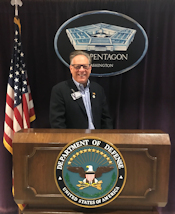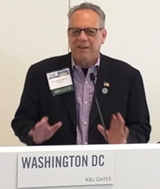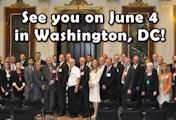NanoBCA Interview: Paul Stimers, Partner, K&L Gates
Posted on April 15th, 2019 | No Comments »
The NanoBusiness Commercialization Association (NanoBCA) is excited to share the next interview of our NanoBCA Interview Series. Through this series we offer in-depth interviews with some of the key stakeholders influencing our nanotechnology community today. Many of these dynamic professionals will be participants at our:

18th Annual NanoBusiness Conference
Tuesday, June 4, 2019
K&L Gates Washington DC
This month we are pleased to share the following interview with Paul Stimers, Partner at K&L Gates and NanoBCA Policy Advisor. K&L Gates will be hosting our 18th Annual NanoBusiness Conference.
Steve Waite: Thanks for taking time to speak with us today, Paul. We are approaching the twentieth anniversary of the National Nanotechnology Initiative (NNI). What have been the major accomplishments of the NNI from your perspective?
Paul Stimers: I think the main accomplishments have been a coordination and acceleration of federal research and development in the nanotechnology space, as well as a more intentional, a more thoughtful, and hopefully more efficient, application of funds to the problems associated with nanotechnology.

PS: That’s an interesting and somewhat challenging question that gets to what I think is one of the missed opportunities of the NNI. That is, we are pretty good at the pure research end of the research, development and commercialization spectrum. Looking back, we were not as good at the development side, and we were quite bad at the commercialization side of things. The NNI made great strides on the pure research side. China took up a lot of our basic research and commercialized it. They did so very aggressively with industrial policy and incentives for companies, including buying the assets of distressed U.S. nanotech companies that were not able to bridge the valley of death between the R&D side and the commercialization/go-to-market side.
SW: What industries have been the biggest beneficiaries of nanotechnology over the past twenty years?
I think that is a very important lesson we learned from the NNI. But to answer your question the rest of the way, one of the key places we have seen a lot of development from the NNI is in novel materials that are used as building blocks for a whole variety of different industries. The materials and the coatings side have been tremendously benefited. I think some of the work in nanoelectronics has been tremendously helpful as well.
SW: Having monitored the nanotech space closely for the past two decades, it seems like U.S. policymakers have been on the one hand, supporting nanotechnology research through the NNI, and on the other hand passing regulations that work against nanotech commercialization. Is that how you see things?
PS: Well I think that is certainly part of it. It was difficult for companies to do IPOs in the U.S. for a long time, although I think it is fair to say that nanotech companies were particularly hard hit. With respect to the NNI, there were a couple of different ways that we slowed our ability to commercialize. One way is by following what is a perfectly reasonable impulse to its unreasonable conclusion. That is, we do not want to pick winners and losers in the marketplace and we do not want to latch on to specific technologies as a government. That is not the role of government in the U.S. But in trying very hard not to do that, we ended up strictly on the pure research side and not providing anywhere near as much help on commercialization as we could have without crossing that line. We did not have much of a push. The second aspect of it is that the NNI was, to some degree, captured by the academic world. There were a lot of universities spending a lot of time and effort and engaging a lot on pure research. That is fine and great. There’s nothing against this, but it did seem to crowd out some vital commercialization activities.
This is where the NanoBusiness Commercialization Association (NanoBCA) comes into the picture. It is a valuable voice in the nanotechnology community. We saw why this was important. We also saw over time the challenges that arise when that voice is not as prominent as the academic voices. At the end of the day, the combination of those two impulses ended us up focusing I think, more than it was optimal, on the pure research side and less than what was optimal on commercialization. As a result, we had a lot of companies in the U.S. that could not cross the valley of death and could not make it.
There is one other aspect of this, and that is the federal government can be very helpful by being a good customer, and by on-ramping nanotechnology-enabled products and working with nanotechnology-focused small and medium-sized businesses to purchase their products and help create a market. Not out of charity or industrial policy, but because the products are going to be very useful to whatever mission or whatever the agency that is buying them is trying to accomplish. A number of agencies, especially the Defense Department, are wrestling with how to be a good customer. This is an ongoing battle that is by no means limited to nanotechnology. It is something that the government recognizes as a challenge. This challenge is limiting our ability to build innovative industries and to ensure that the latest and greatest new products get to the government as a customer.
SW: What government agencies have benefited the most from the NNI’s initiatives?
PS: Unquestionably, the research agencies such as the NSF and NIST have been big beneficiaries. If you are talking about mission-focused government agencies whose mission is not research, they have had some successes. But better commercialization efforts could have given them more successes.
SW: How do you see the NNI evolving in the years ahead?
PS: The NNI itself is in the process of winding down. Congress has indicated a desire to do that. I think this is a recognition that the field has matured to a substantial extent. Let me emphasize that nanotechnology is not an industry.
SW: Correct! There is a tendency to confuse a disruptive technology such as nanotechnology with being an industry.
PS: Right. My sense is that the bootstrapping mission of the NNI has been successful and is no longer such an urgent priority, which is great. I think we will see a continuation of research activities of the two dozen or so agencies that have been involved in the NNI, with a little bit less of a centralized clearinghouse like the NNCO – the National Nanotechnology Coordination Office – being needed to make sure we are not having gaps and overlaps. I think the natural progression of research is going to take the interested parties in their own direction. The field is mature enough now, and characterized well enough now, that people understand what is going on.
SW: What are some of the challenges facing policymakers in the realm of nanotechnology?
PS: I think there are issues related to EH&S – Environmental, Health and Safety. Those issues continue to lurk and will be ongoing issues if there are flare-ups – stories in the media or studies that are done that attract attention. In general, nanotechnology is vastly better for the environment than the technologies it is replacing. It enables a tremendous amount of environmental benefit. It enables a tremendous amount of health and safety benefits as well. But, of course, the media will want to focus on negative aspects because that will be what drives views. We also have to keep an eye out for this and be prepared to tell the other side of the story.
SW: Which typically does not sell papers and attract views.
PS: Right. The second area policymakers will focus on in the future is in areas where nanotechnology plays into activities such as advanced manufacturing. EH&S and advanced manufacturing are the primary areas I see immediate potential interest from U.S. policy makers. For now, we can expect a somewhat quiet period as nanotechnology returns to its original fields and progresses along within those.
SW: What kind of advice would you give to policymakers today with respect to encouraging investment in nanotechnology?
PS: To begin with, anytime we are dealing with a disruptive technology, it is important to help policymakers understand what it is and why it is important intrinsically. In the case of nanotechnology, we speak about it having to do with a certain scale and the special characteristics that emerge at that scale. Then we discuss why we can use those characteristics to do new things that were previously unavailable to us. Then we take this and apply a public policy lens to it. We address why it is important that we be leaders in this field and what it means for U.S. innovation, jobs, and national security and international trade. This is the positive case we build for nanotechnology.
After that, we begin discussing what we need to do to make U.S. leadership happen. In the case of the case of the NNI, it was, “Let us coordinate and accelerate federal nanotechnology R&D. Let’s get everybody together and understand what’s going on so we can think carefully about where to invest – based on our comfort that we are doing the right thing and not duplicating efforts and leaving substantial gaps in our research. Let’s go ahead and put more money toward the R&D because we believe we are not wasting it. Then hopefully we will do a little bit better on the commercialization side of it.” The end goal is to have all of that trickle out through the scientific process and the marketplace to the benefit of U.S. citizens and the U.S. economy.
SW: You recently launched the Quantum Industry Coalition and are leading the charge on the quantum front in the U.S., of which nanotechnology is part. Tell us about the purpose of the coalition.
PS: The Quantum Industry Coalition was a direct result of my work with the NNI and the NanoBusiness Alliance and the NanoBCA. About two and a half years ago, I started seeing around the quantum fields – quantum computing, cryptography, communications and sensors – the same sorts of things I had seen twenty years ago around nanotechnology. I had seen a bunch of small companies, each of which had radically different approaches to addressing the problem. I was seeing a smattering of federal R&D funding that was not particularly coordinated or thought out from a strategic perspective, although each of the particular projects made plenty of sense. I also saw a significant international competition aspect and a national security aspect. When all of those things are present, what I learned from the NNI is that we need a national coordination and acceleration plan to ensure U.S. leadership in the field.
I started speaking with quantum companies and asking them what they thought about whether or not we needed such a thing as the Quantum Industry Coalition. Quite a number of them agreed that we do need a National Quantum Initiative like the NNI. We formed the new coalition to advocate for just that purpose. As it turned out, as we were pulling the coalition together we learned that the House Science Committee was putting together legislation to do precisely that. We had an opportunity to consult with them as they drafted that legislation – to make some suggestions from the perspective of the U.S. quantum business community, and then to help pass the bill.
The bill was remarkable in that it had bi-partisan, bicameral support from the get-go. It passed the House of Representatives quite quickly and overcame a little jurisdictional hiccup to pass the Senate. It was signed by the President in December. All of which took less than a year, which is blindingly fast from a Congressional perspective. I had planned to use the coalition to press for this bill all of this year and possibly all of next year. We have had to come up with new things to do since the bill has already passed, which is a nice problem to have. In fact, what we are spending this year doing is ensuring that the National Quantum Initiative is funded and is implemented well by the Administration. We are also working on developing an analog initiative for the defense side and the intelligence community side, because the National Quantum Initiative Act focused entirely on civil quantum.
SW: Who are some of the companies in the coalition and what types of things are they working on?
PS: We currently have fifteen members. There is a mix of large and small companies, some pure-play quantum and some very much “not just quantum.” What they all have to have in common is a desire for the U.S. to be a leader in the quantum fields. Beyond that, anything that they are doing in quantum is fine with us. Our goal is to be strictly business. That is, we don’t have non-profits, academics, or professional societies involved. We have nothing against them. There are other organizations that we work with very closely who have those voices in them. But our charter is strictly the voice of the U.S. quantum business community and those internationally who support U.S. leadership. We want to make sure we are just business, but we want to make sure we are ecumenical within quantum. We are not picking different methods or technologies. And we are also consensus-based. We require everybody’s buy-in before we do anything. What that means is we are driven to the fundamental principles everybody can agree on even though they may be competing against each other tooth and claw. This gives us a very effective platform in which to operate.
SW: What is your view of quantum computing? There are some naysayers out there who think it will be many decades before we see commercial quantum computers.
PS: There have always been naysayers around any disruptive technology. I am not aware of a disruptive technology did not have an army of naysayers around it. The trick, of course, is distinguishing a disruptive technologywith an army of naysayers around it from quackery with an army of naysayers around it. That is hard to do. Equally hard, if not harder, is nailing the timing. We do not know what will pan out or when. There are people who are working right now on time horizons in the twenty-year range and there are people who may have something within the two-year range. The thing is, you never can tell who is going to win and when.
SW: One of the best quotes I’ve seen on quantum computing recently came from MIT professor of physics and electrical engineering, Isaac Chuang, who said: “The thing driving the hype is the realization that quantum computing is actually real. It is no longer a physicist’s dream—it is an engineer’s nightmare.” Does that perspective resonate with you?
PS: Yes, it does resonate. A lot of the issues we are wrestling with are engineering challenges. I deal with the commercial space industry and there are some useful parallels. For instance, when people were talking about building airplanes back in the late nineteenth and early part of the twentieth century, the general expectation at the time was that the first airplane was going to be developed by Samuel Langley, the Secretary of the Smithsonian at the time. He had a tremendous amount of funding and support. He was going to be the guy who finally got us off the ground. As it turned out, his airplane was a disaster. It was a couple of bike mechanics out of nowhere – the Wright brothers in Ohio – who achieved the first powered flight.
This is a lesson that shows that we just don’t know what will happen, especially when you are dealing with a technology that, all things considered, does not require a massive capital investment in order to play. You should be very careful about assuming that an entrant can’t disrupt, even a very non-traditional entrant. You may need a billion dollars to build a microchip fab or to manufacture a passenger aircraft, but you don’t necessarily need a whole ton of money to make a real impact in quantum. We do not know where it will come from, and we cannot accurately predict the timeline. We can be humble about it, we can warn that there will be hype, and we can stick to principles like “no technology mandates,” “not picking winners and losers,” things like that, that should protect us from having the federal government invest somewhere that turns out to be worthless or turns out to be a poor decision. We need to be really careful about pretending we know more than we do.
SW: Well stated, Paul! Do you sense a growing awareness in Washington of the potential threat of quantum computing to cyber security?
PS: Yes. I think about this frequently and work on it constantly. It is a serious issue. What I see is that a country such as China is moving forward with quantum in a big way, with a plan that is directed at both developing an advantage over the U.S. and attacking our own capabilities. I believe we need to take what China is doing seriously. We recall the Sputnik moment, but what we don’t recall is that it was actually three moments. The Soviets launched the first Sputnik satellite, and that was a surprise and caused great consternation. Then, a month later, they launched a second satellite which demonstrated a proficiency at doing it. Then, third, when the U.S. tried to answer the Soviets, we failed. The rocket we built that was supposed to carry our own satellite blew up. It was a disaster. It was after that failure that the U.S. really got serious.
China has now demonstrated a capability to have a quantum downlink from a satellite, which is something that, at least publicly, we are not able to replicate. They have also demonstrated a quantum broadband connection, another capability that, at least publicly, we are not able to replicate. Thirdly, they have dedicated $10 billion in funding to a quantum cluster in China. This is a level of funding commitment that, at least publicly, we are not able to replicate. Our own funding for the National Quantum Initiative is $1.25 billion over five years. The three quantum developments, taken together, indicate to me that China is worth taking seriously. Now, China’s focus so far has been on quantum communications. That’s interesting. In the U.S., we are more focused on quantum computing. My expectation is that China will attempt to acquire our quantum computing capabilities by hook or by crook and is counting on us to develop it, so they can have it later. I don’t believe we should be complacent about that at all.
SW: That makes sense. Thanks for your perspectives on the Quantum Industry Coalition and related quantum developments. We look forward to hearing more in the future. I wanted to ask you about one of your other areas of specialization. You work closely with the commercial space industry. Tell us about the work you do in this area.
PS: For the last twelve years or so, I have been involved in commercial space policy, which has involved representing the industry association for commercial space flight as well as many of its members in the launch space, in the satellite space and advanced manufacturing, off-world and asteroid mining and other related things. It has been incredible to be at the policy center of another major revolution in our capabilities. Over the last couple of years, we have gone from traditional space, where the government builds, owns, and operates a rocket, to an entirely new paradigm where the government is buying rides on rockets that are manufactured by private industry.
In this emerging new paradigm, the government is the customer rather than the owner and operator. We are also seeing, for the first time, reusable rockets. Imagine how often you would fly if you had to throw out the plane every time you flew somewhere. That’s what we have been doing. Now that we have reusable rockets, thanks in part to nanotechnology and a number of industrial innovations, all of a sudden – literally just in the last couple of years – that has gone from impossible to “of course that’s what we do.”
This fundamental shift has been really incredible. What we are going to continue to see is the development of this commercial space infrastructure that enables people to innovate at the application layer, just as Amazon and Facebook and others were able to take advantage of the internet and other aspects of the physical infrastructure level to innovate at the application layer and change the world. We are going to start seeing that capability develop with respect to space. I think this is an extremely exciting time for the country and for the world. This is like the dawn of aviation. It is the change between government-led exploration and private sector expansion. It’s the change between the Lewis and Clark expedition and the wagon trains. It’s just a tremendous time to be around for, let alone to be a part of it.
SW: What are some of the major milestones we are likely to see in the commercial space industry in the years ahead?
PS: Well, just last December, Virgin Galactic sent its first commercial astronauts to space as part of its test program getting ready to fly paying customers into space. They were awarded astronaut wings by the U.S. Secretary of Transportation. The engine that powered them into space is now on display at the Smithsonian’s National Air and Space Museum. Virgin Galactic followed this up last month with a second test flight in which they had a third person in the cabin who became the first female commercial astronaut to go to space on a commercial vehicle.
When Virgin Galactic and Blue Origin and the other launch vehicles come on line in the next year or so, we are going to start having people going to space in large numbers. A suborbital trip to space on Virgin Galactic will cost $250,000. Blue Origin has not listed a price but it is expected to be somewhere in that neighborhood. Already, Virgin Galactic has signed up and taken deposits from more people than have ever been to space in human history. Just on the strength of their backlog, they are already set to more than double the number of people that have been to space.
SW: Fascinating stuff, Paul! We could talk all day about this, but unfortunately, we don’t have time. In the remaining time we have today, I wanted to have you tell us about K&L Gates and the types of services it provides to entrepreneurs of emerging technology companies. You have a heritage of helping disruptive technology companies.
PS: Yes, the Gates in our name is that Gates. We are tremendously honored by that heritage with Microsoft and the Gates family. Our firm is a global law firm with offices across five continents with just under 2,000 lawyers on staff. We pride ourselves on being extremely friendly to emerging companies, both in terms of growing early stage companies and in terms of helping disruptive companies and companies that are creating disruptive industries. That means everything from having one of the world’s leading IP practices with more engineers and scientists than you can shake a stick at on staff, to having people who focus on VC funding and other ways of raising capital, to corporate lawyers who deal with mergers and acquisitions and so forth.
My own aspect of the practice is focused on the policy side and advocating for disruptive technologies in Washington, D.C. The policy environment is created for and by incumbents, by the industries that are being disrupted or that other companies want to disrupt. Therefore, finding ways to make the policy environment safe for, if not helpful to, those disruptors is challenging. That is what I try to do.
SW: What are some of the main lessons you have learned in working with emerging technology companies during your career?
PS: I think the main thing I see is that when you have a new, disruptive technology and you are excited about it, you see its value. You are committed to it. It is validated and so forth. There are all sorts of opportunities that you can pursue with that technology. Time after time, we see executives want to try to do all of it, because it is all exciting. There is money associated with all of it. We counsel our clients to make and stick with a plan and focus on one or two things that are right on your development path, and not to get sidetracked by all of these interesting opportunities. If you chase the whole school of fish, you are unlikely to catch any of them.
Our experience is very useful to our emerging company clients. We help them stay laser focused on what they are doing. We will show them the opportunities and then we will help them work through the process of deciding, “Is this really the thing that I should focus on or not?” It is those companies that have stuck with a focus and only worked with the government or taken advantage of a government opportunity when it really dovetails with what they want to do and had planned to do – it is those companies that have the most long-term success. Our fondest hope is that our emerging company clients will be successful over the long term and will grow into the kind of company that our namesake helped found all those years ago.
SW: Right on, Paul! That is terrific advice. Thank you for it and for all of your time today. We really appreciate it. The NanoBCA thanks you for your excellent work over the years in the nanotechnology community. We look forward to the collaborations ahead.

Steve Waite is a member of the NanoBCA Advisory Board and author of several books including Quantum Investing and Venture Investing in Science.
I hope you enjoyed this month’s interview. Looking forward to seeing you on June 4th in DC!




